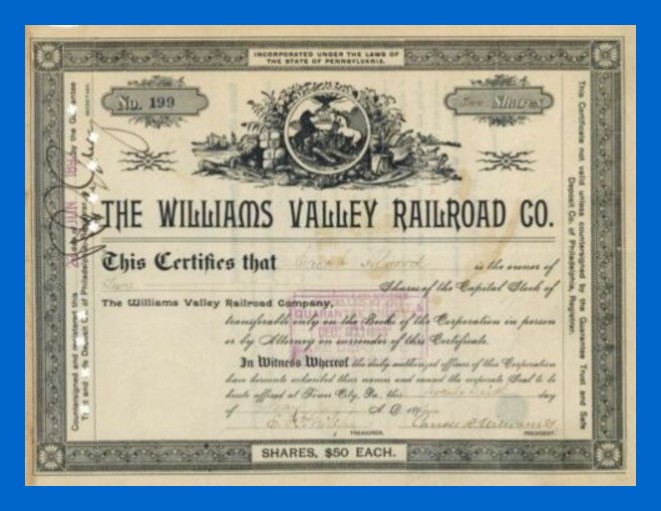The following articled appeared in the West Schuylkill Herald, November 3, 1967, as a reprint of an article that originally appeared in the same paper, April 19, 1907.
THE HISTORY OF THE WILLIAMS VALLEY RAILROAD
The road commenced operating July 1, 1892, and was built in order that the residents of this valley might enjoy railroad facilities that had heretofore been denied them. Previous to the building of the road the nearest railroad station was the Philadelphia and Reading at East Brookside, on Brookside Mountain, about two miles east of Tower City.
Stage coaches were used to transport passengers to and from the station to the various towns in the valley. Passengers were charged 25 cents from the station in Tower City and larger sums to Williamstown and Lykens. Mail and express was also carried by stage coaches. Merchants from this end of the valley had to haul all their freight from East Brookside at considerable cost, besides the heavy expense by the wear and tear to their teams caused by the heavy mountain grades to and from the station.
The original charter was issued September 19, 1991, and was signed by Governor Patterson. It was for 3 3/10 mile from Brookside, the terminal of the Philadelphia and Reading Railway, to Tower City. The original promoters of the road were all residents of Tower City. The progressive citizens of Williamstown and Lykens, seeing the benefits to be derived by having a railroad at their very doors, petitioned the promoters of the project to have the road extended to those towns. This was finally agreed to and the road extended, which made it possible to connect with the Pennsylvania Railroad at Lykens. Shortly after the road was built, the Pennsylvania Railroad abandoned all passenger trains between Lykens and Williamstown.
The first officers of the company were as follows: J. Jamison, president; C. M. Kaufman, general traffic manager and secretary; A. F. Baker, general manager; E. F. Philips, treasurer. Directors: J. F. Durbin and Amos Lake, Williamstown; Edward Lebo and John L. Matter, Lykens; Isaac Mossop, Wiconisco; A. F. Baker, Norristown; E. F. Philips and C. M. Kaufman, Tower City.
Several years ago, John Jamison, who was the contractor that built the road, withdrew his interests and C. M. Kaufman was elected to succeed him. Baker and Matter have since died and their places were taken by H. T. Bressler of Tower City, and L. L. Pritchard of Williamstown. C. M. Kaufman was also elected general manager after the death of A. F. Baker.
The company has an authorized capital of $120,000, of which $90,000 is outstanding. It was originally bonded for $90,000 but this was increased to $120,000 several years ago.
The road is about 13 miles in length. It connects East brookside with the Philadelphia and Reading Railway and extends to Lykens, the terminus of that place being within three squares of the Summit Branch Railroad, which is operated by the Pennsylvania Railroad. It operates through a district the population of which is nearly 20,000. The road owns its own equipment, consisting of an engine and three passenger coaches, has three handsome and well-constructed depos and a large engine house. The general office of the company has always been at Tower City. The road bed at this time is in better condition than at any time in the history of the road.
During the 15 years that the road has been in operation only one employee has lost his life while in the performance of his duties, George Kantner having met death by being badly crushed while coupling cars at Brookside Colliery several years ago. Outside of the above none of the employees were ever seriously injured. Several persons met death while walking on the railroad, however, but in every case the company was exonerated from all blame.
The company was fortunate, considering the dangerous grades and curves, that it never had any fatal wrecks. While a number of accidents have taken place, only two came any way near being fatal, one at Reiner Station several years ago, when the engineer lost control of his train on the steep grade and the engine and one passenger coach was badly wrecked; the other near Snyder’s planing mill in town when the train ran into a cow, badly wrecking two freight cars. No persons were injured in either wreck.
Little Things of Interest
During the past week this valley was visited by more prominent railroad men than ever in the history of the valley.
Among those who attended this meeting of the directors of the Williams Valley railroad, held at this place on Monday, were the following: Theodore Vorhees, vice president; W. R. Taylor, secretary; George Zeigler, controller; Edson J. Weeks, general passenger agent; B. H. Ball, freight agent; A. T. Dice, general superintendent; H. D. Taylor, superintendent of motive power; William Hunter, chief engineer; W. H. Keffer, superintendent Reading division; B. W. Saterlee, assistant train master; besides a number of minor officers, all of the Philadelphia and Reading Company.
The party came here in a special train made up of vice president Vorhees’ private car and a diner. Observation engine No. 101 was also brough along to convey the party over the road. Many of these officials had never visited the Williams Valley before and to them the visit was a revelation. They expressed genuine surprise and were greatly taken up the beauty of the valley. The cleanliness of all the towns in the valley also came in for favorable comment.
On Wednesday about a dozen minor officials of the Reading Railroad spend several hours going over this territory. They also expressed themselves as well pleased with what they saw and learned while here. On Thursday another set of officials was here.
